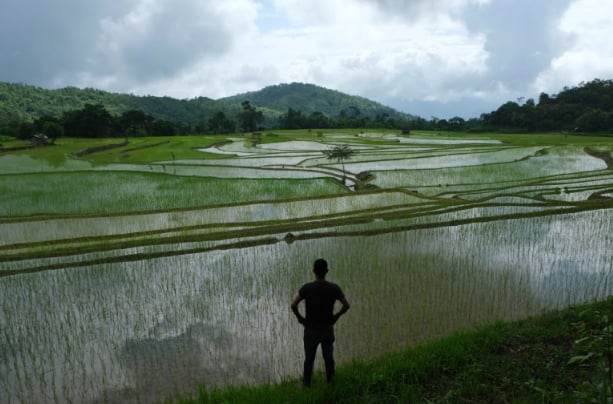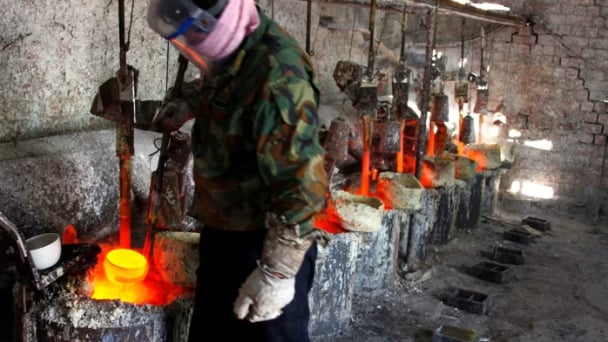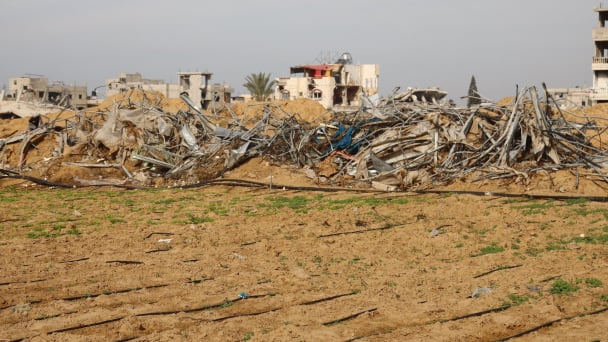June 18, 2025 | 22:42 GMT +7
June 18, 2025 | 22:42 GMT +7
Hotline: 0913.378.918
June 18, 2025 | 22:42 GMT +7
Hotline: 0913.378.918

In parts of India, crops have been destroyed by both incessant rain and by the lack of it. Photo: AP
In Haryana’s Bithmara, about 200 kilometres (124 miles) northwest of the capital New Delhi, 37-year-old Satish Jangra is distraught after seeing his paddy crops destroyed due to untimely and incessant rainfall in early August.
“I am compelled to leave farming. The cost is much more than the output and I am falling into a debt trap,” he said.
Each year, Jangra would till 3 hectares (8 acres) of his neighbour’s land in which he cultivated mostly paddy and other grains like wheat and millets. That has now been reduced to 1 hectare (3 acres). He is thinking of either changing the paddy field to another crop variety or stopping tilling the land altogether so that he does not have to worry about the losses each year.
“You spend thousands on different fertilisers, diesel, water etc and when it’s time for output for paddy especially, you just get into losses,” he told Al Jazeera.
Traders pay according to the quality of the rice, but over time farmers say, the quality has decreased.
He still has to pay a $600 loan to the bank and for that, he is now looking for an alternative.
“I have started working in a small furniture shop because I cannot be dependent on just farming,” he said.
In eastern India’s Jamui Bihar village, farmer Rajkumar Yadav’s troubles are the opposite of Jangra’s as he waits for rainfall so that his paddy crops do not dry up.
Each morning and evening, the 55-year-old’s family takes water from their well to sprinkle on the crops. He says his family can no longer rely on the monsoon.
“In our area only 10 percent sowing of crops has happened so far because there is no rainfall. We all are dependent on the Tubewell [used to pump groundwater], which is also drying due to high temperatures,” he said.
About 68 percent of the total cropping area in India is rainfed. Of the roughly 40 million hectares (100 million acres) of the rice-harvested area in India, 60 percent is irrigated leaving the rest dependent upon rainfall, and hence susceptible to drought.
Aditi Mukherjee, principal researcher at International Water Management Institute (IWMI), a nonprofit research organisation, said overall, climate change has increased the probability of extreme events.
While “impacts of droughts can be somewhat mitigated through access to irrigation, parts of India [such as eastern India which is a major rice basket], do not have adequate affordable irrigation, and depend mostly on expensive-to-operate diesel pumps,” she said.
This year paddy sowing has been affected in key rice-producing states like Uttar Pradesh, Bihar and West Bengal, resulting in a 13 percent lag in area under paddy.
A ban on rice exports?
IWMI’s Mukherjee told Al Jazeera that it is going to be a hard year for farmers.
“Heat waves, followed by drought-like conditions due to late arrival of monsoons, have impacted two main crops, wheat in the previous season, and now rice,” she said, adding that such late sowing of paddy is likely to affect yield, and also delay the next cropping cycle.
And while it is not clear as yet what sort of shortage that will result in when the harvest finally comes, the United States Department of Agriculture has estimated that rice production may reduce by 0.9 per cent, the first decline since 2015. That leads experts to say they need to monitor the situation closely, especially if the government decides to ban or limit its exports as it did in May for wheat.
Tavseef Mairaj Shah, who works in agroecology, warns that while a ban on rice exports would be catastrophic for the global food supply, such a move is not currently expected, although a rise in rice prices is not off the cards.
The threat to India’s rice production also comes at a time when countries are already grappling with soaring food costs. The decline in production that farmers foresee could make India’s battle against inflation more difficult and lead to export restrictions.
In India, rice is a staple food for more than half the population. Bangladesh, China, Nepal, and certain Middle Eastern nations are among some of its top clients, as India exports rice to more than 100 countries.
“India has to take in consideration the domestic food security aspect. While we currently have grain stocks, we may have to buffer in case the Ukraine war continues,” said Srinath Sridhan, an independent markets commentator.
But eventually, to ensure food security, India needs to reimagine its agricultural practices, scientists say.
“The unprecedented change in rainfall patterns, droughts and extreme heat is a stark reminder that India needs to uphold and promote a transition from mono to multi-cropping systems,” said Rohin Kumar, senior agriculture campaigner at Greenpeace India.
Monoculture kills all the nutrients from the earth, weakening the soil, which in turn inhibits healthy plant growth.
With the effects of climate change and the extreme weather expected to aggravate in coming years, India also needs to create adequate demand and supply of many local indigenous grains, vegetables and fruits, with urban communities stepping in to support farmers by directly buying from farmers, Kumar said.
Agroecologist Shah agrees that there is an “urgent need” to transition to sustainable methods of rice cultivation to improve water use efficiency, farmers’ livelihoods, and make them capable of adapting to changing weather patterns and extreme weather events.
While a government push to make any of these suggestions a reality is currently not on the table, farmers like rain-starved Yadav have already switched to cultivating different crops to make a living.
“We have started cultivating coriander, and I think that that helps me a bit to sell it in my village,” he said.
In Jamuai village, where Yadav lives, besides growing paddy and other crops, farmers have been doing organic farming, shunning the use of chemicals. And while they have been at it for half-a-dozen years, they are yet to find people willing to pay the premium prices that this process demands.
“We have been trying to raise awareness about organic products but that is not happening much. When it comes to profit, no one thinks about the farmer,” he said.
(Al Jazeera)

(VAN) Extensive licensing requirements raise concerns about intellectual property theft.

(VAN) As of Friday, a salmonella outbreak linked to a California egg producer had sickened at least 79 people. Of the infected people, 21 hospitalizations were reported, U.S. health officials said.

(VAN) With the war ongoing, many Ukrainian farmers and rural farming families face limited access to their land due to mines and lack the financial resources to purchase needed agricultural inputs.

(VAN) Vikas Rambal has quietly built a $5 billion business empire in manufacturing, property and solar, and catapulted onto the Rich List.

(VAN) Available cropland now at less than five percent, according to latest geospatial assessment from FAO and UNOSAT.

(VAN) Alt Carbon has raised $12 million in a seed round as it plans to scale its carbon dioxide removal work in the South Asian nation.

(VAN) Attempts to bring down the price of the Japanese staple have had little effect amid a cost-of-living crisis.